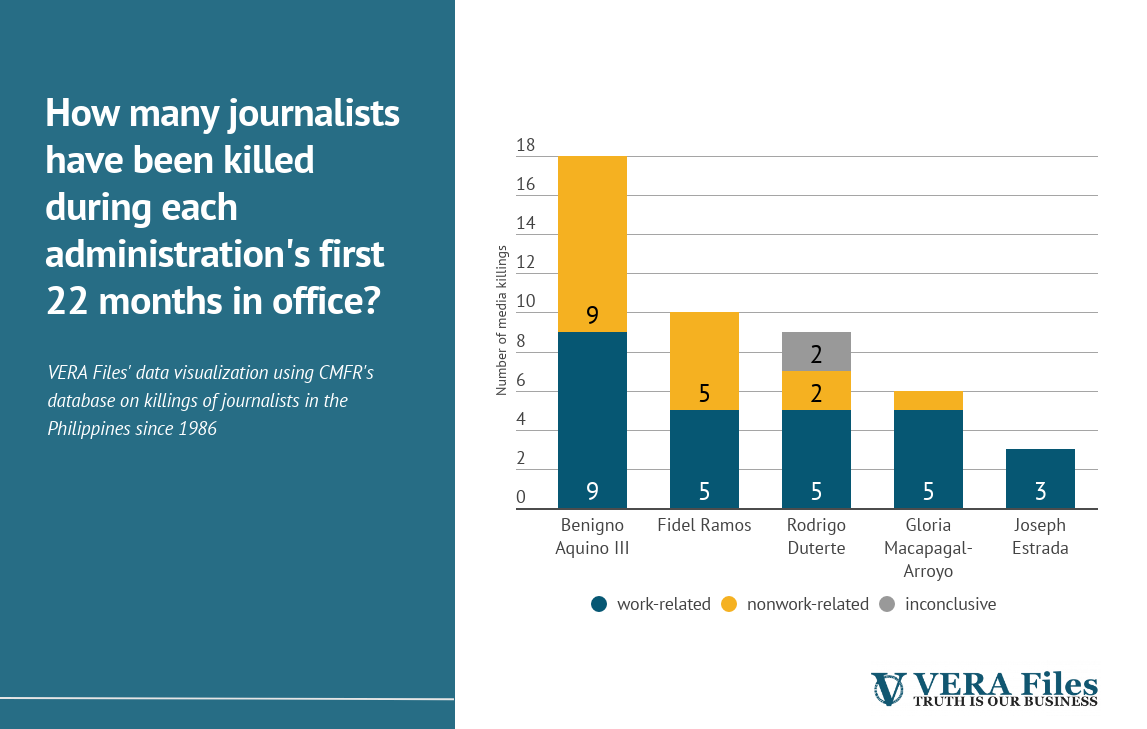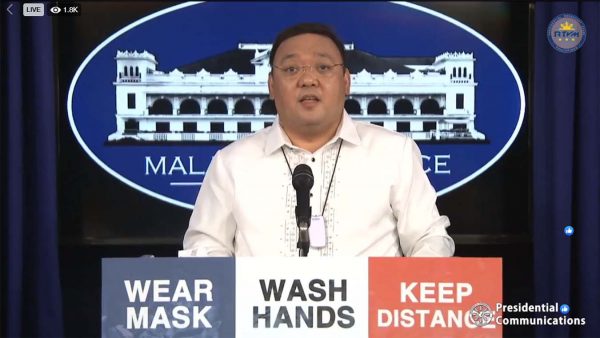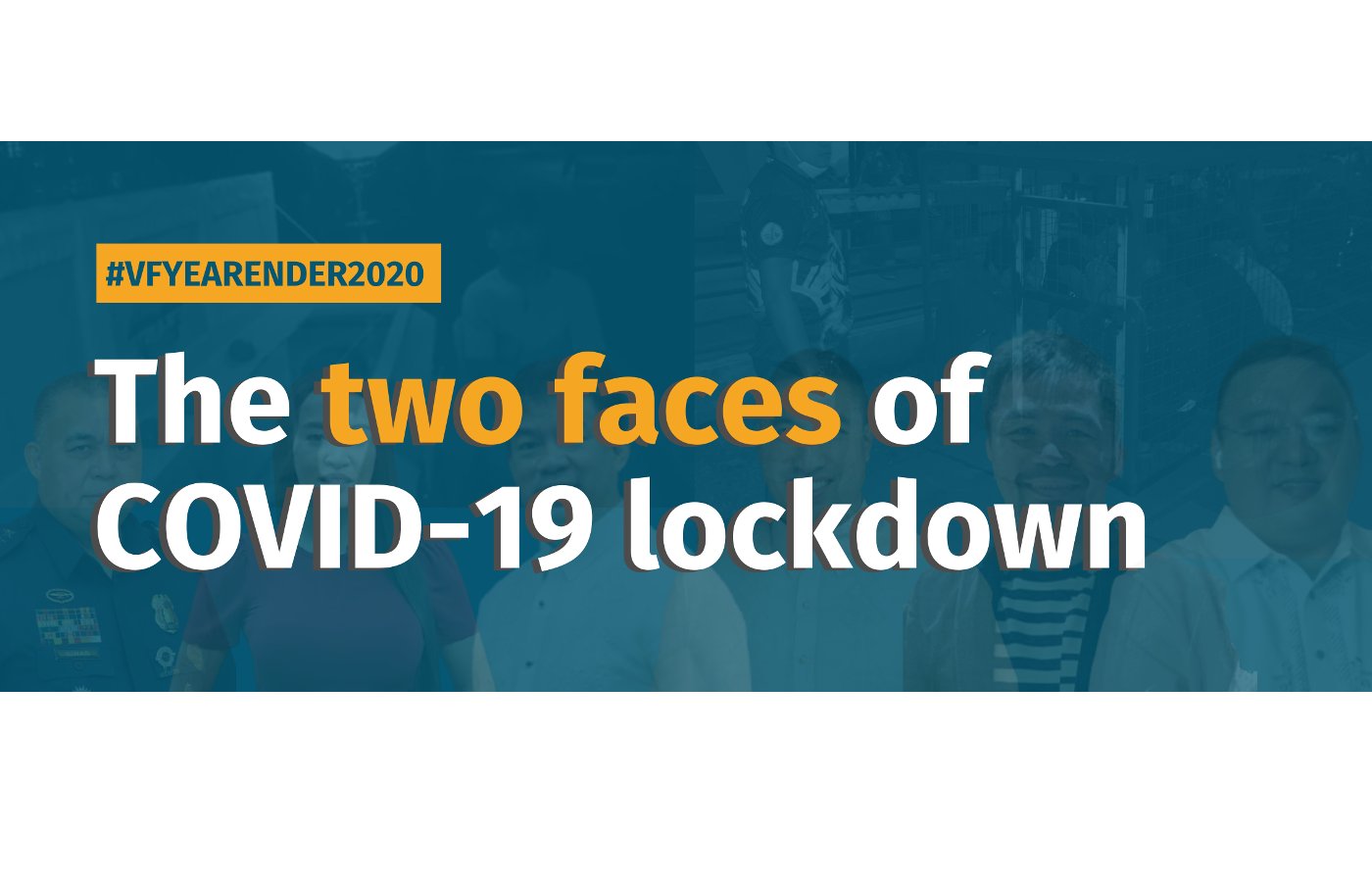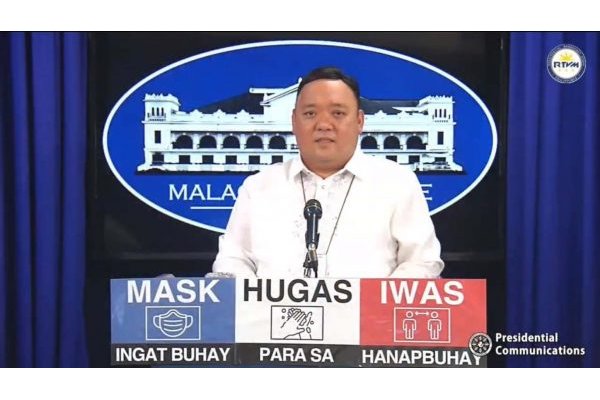(UPDATED) Four media groups incorrectly claimed in a May 3 report that the Rodrigo Duterte and Benigno Aquino III administrations each recorded nine media killings in their first 22 months in office, the highest since 1992.
The reason the number of killings during Duterte’s first 22 months matched those of Aquino III’s is because the media groups counted both work- and nonwork-related killings under Duterte and only work-related killings under Aquino III.
The media groups also inaccurately stated in their report that Duterte’s record exceeded those of Arroyo, Estrada and Ramos presidencies during their first 22 months.
Palace Spokesperson Harry Roque later “disputed” the report and claimed two things: First, the media killings actually went down under Duterte; second, the Philippines became less dangerous a place for journalists.
Roque’s first claim is true; the second is false.
STATEMENT
On World Press Freedom Day, the Center for Media Freedom and Responsibility, National Union of Journalists in the Philippines, Philippine Press Institute and the Philippine Center for Investigative Journalism provided a tally of media killings:
“The nine journalists killed during the first 22 months of Duterte’s presidency are a perfect match to the number recorded during the same covered period under Benigno S. Aquino III.
Duterte’s record, however, exceeds those in the first 22 months of Fidel V. Ramos, Gloria Macapagal Arroyo, and Joseph Ejercito Estrada.”
Source: Center for Media Freedom and Responsibility, May 3, 2018.
They supported their statement with a graph of media killings in the first 22 months of each administration:
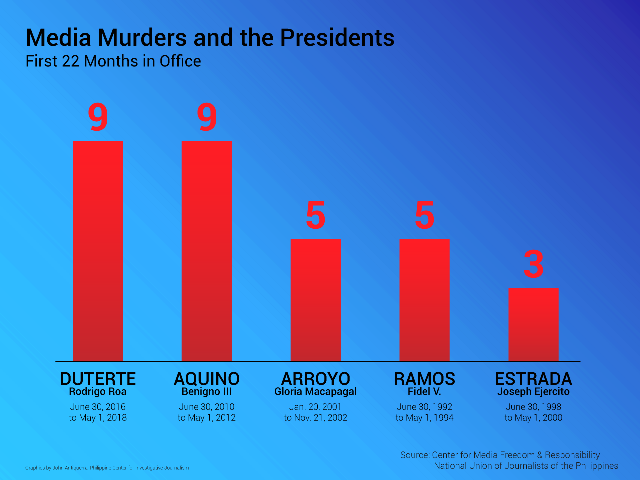
They also named the nine journalists who have been killed under Duterte’s watch.
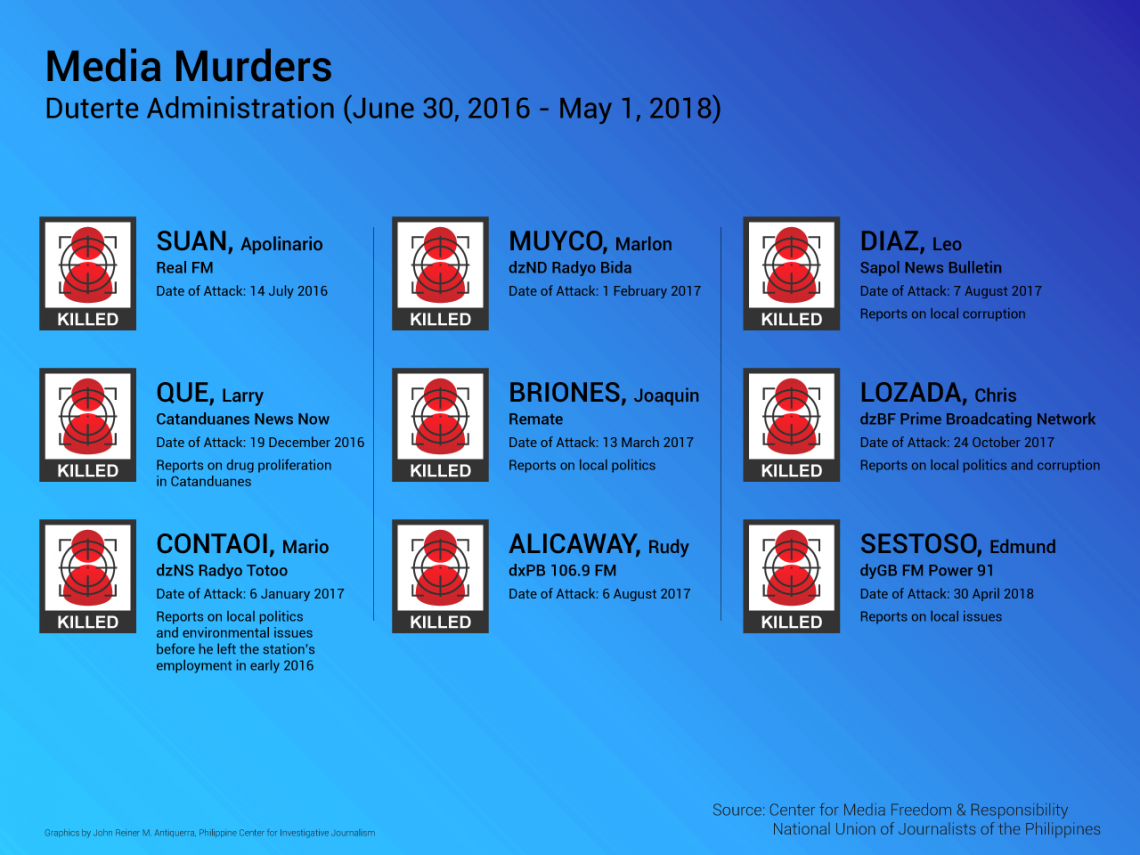
Source: Philippine Center for Investigative Journalism, May, 3. 2018
Roque, sought for comment in a same day press briefing, said:
“Well, I dispute that po, kasi pagdating sa patayan, bumaba po talaga ang patayan sa Pilipinas at bumaba po ang ranggo ng Pilipinas doon sa mga listahan ng (because media killings went down and the Philippines dropped in the rankings of the) most dangerous places in the world for journalists. Let’s give credit where it is due.”
Source: Press Briefing of Presidential Spokesperson Harry Roque, May 3, 2018, watch from 5:04 to 5:17.
FACT
The number of media killings in the first 22 months of Aquino III and that of Duterte do not match, as the media groups claimed.
If only confirmed work-related killings were counted, there were nine under Aquino III and five under Duterte, based on CMFR’s own database on media killings.
And if both confirmed work- and nonwork-related killings were counted, there were 18 under Aquino III and nine under Duterte, according to the CMFR data.
In their May 3 report, the media groups tallied only work-related killings under all administrations except for Duterte, whose record also included nonwork-related killings and inconclusive cases.
CMFR’s online database also shows that the five confirmed work-related killings in Duterte’s first 22 months in office matched–and not exceeded as the media groups said in their report–Gloria Arroyo’s and Fidel Ramos’ records. The Duterte administration, however, surpassed Estrada: Three work-related media killings occurred during Estrada’s first 22 months.
Media watchdog CMFR provided VERA Files May 8 a list of the nine journalists killed under Duterte.
Of the nine deaths mentioned in the report, seven appear on CMFR’s online database, five of which are confirmed work-related and the remaining two confirmed nonwork-related.
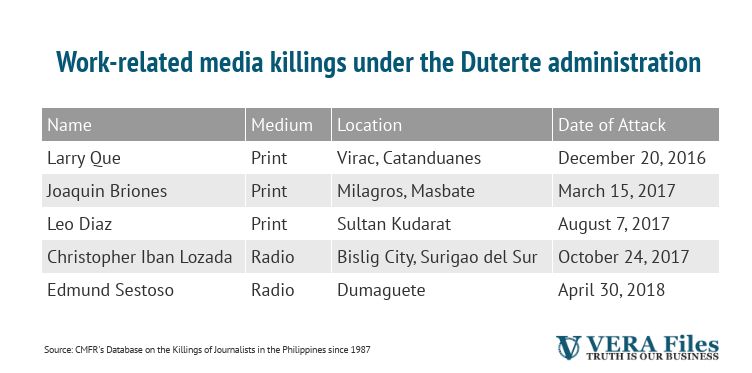
The other two names that were not included in the database, Marlon Muyco and Apolinario Suan Jr., were culled from data consolidated by CMFR and NUJP. Reports point to the motives of their killings as still being inconclusive.
Analysis of CMFR data on media killings since 1987 show the first 22 months of the Corazon Aquino administration witnessed the highest number of work-related media killings at 11; and two nonwork-related killings.
Even as media killings have dwindled, as Roque correctly said, the state of press freedom in the Philippines has worsened, contrary to his claim.
While Roque did not provide the basis for his claim that the country’s ranking in the most dangerous places for journalists has dropped, rankings from Paris-based media watchdog Reporters Without Borders (RSF) show a deteriorating media situation in the Philippines.
In 2018, the Philippines ranked 133rd in the World Press Freedom Index, six notches below its ranking in 2017. It is colored red on the global map, which indicates a “bad” press freedom situation.
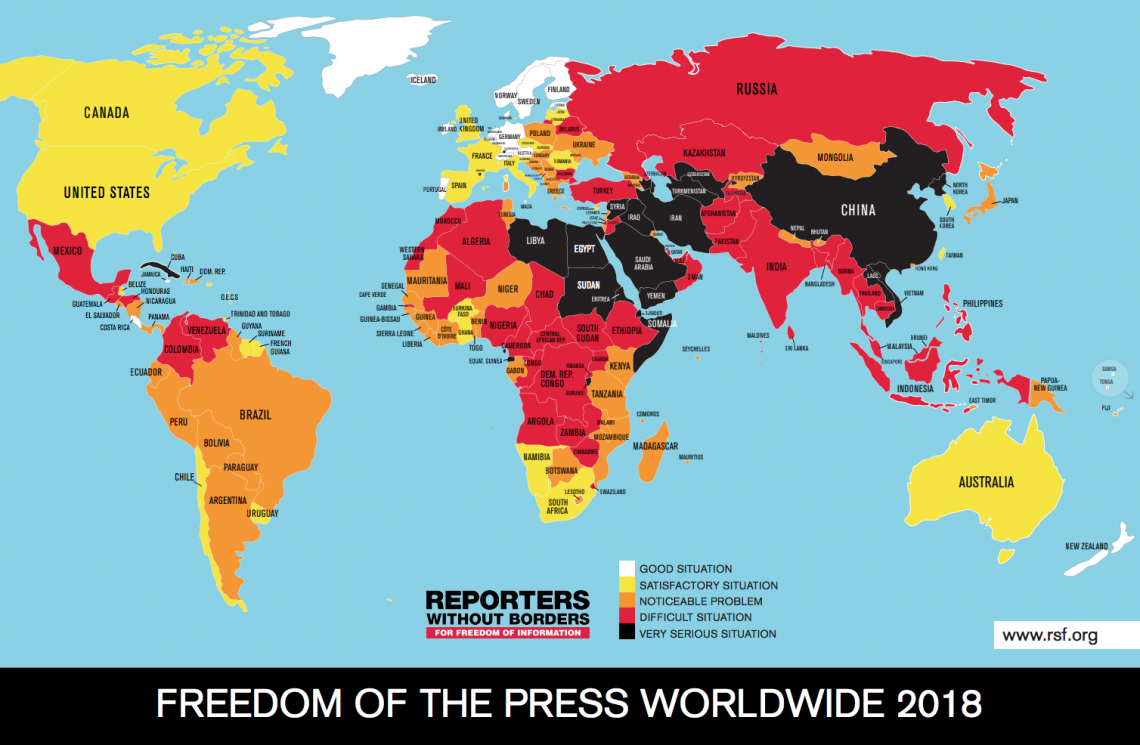
(Screengrab from Reporters Without Borders’ website)
The index ranks 180 countries based on the level of freedom available to journalists, providing a snapshot of the media freedom situation based on pluralism, independence of the media, quality of legislative framework and safety of journalists.
The index also keeps a detailed tally of abuses against the media through an abuses indicator, calculated based on the intensity of abuses and violence in a given period.
In 2018, the Philippines got an abuse score of 58.9, the 18th in rank among 180 countries evaluated.
An analysis of the press freedom index by the RSF in 2018 reads:
“The line separating verbal violence from physical violence is dissolving. In the Philippines (down six at 133rd), President Rodrigo Duterte not only constantly insults reporters but has also warned them that they ‘are not exempted from assassination.’”
Source: Reporters Without Borders, 2018
More, the Philippines placed fifth among 12 countries that figured in the 2017 Global Impunity Index of the Committee to Protect Journalists, which ranked countries “where journalists are murdered and their killers go free.”
In order of their rank in the impunity index, the other countries are Somalia, Syria, Iraq, South Sudan, Mexico, Pakistan, Brazil, Russia, Bangladesh, Nigeria and India.
Extremist and criminal groups are the common killers in most countries, save for the Philippines, Russia and Brazil where government officials are those “getting away with murder,” according to the index.
UPDATE: NUJP, in a statement posted on Twitter, said it “stands by its findings that nine (9) journalists have been killed under the Duterte administration.”
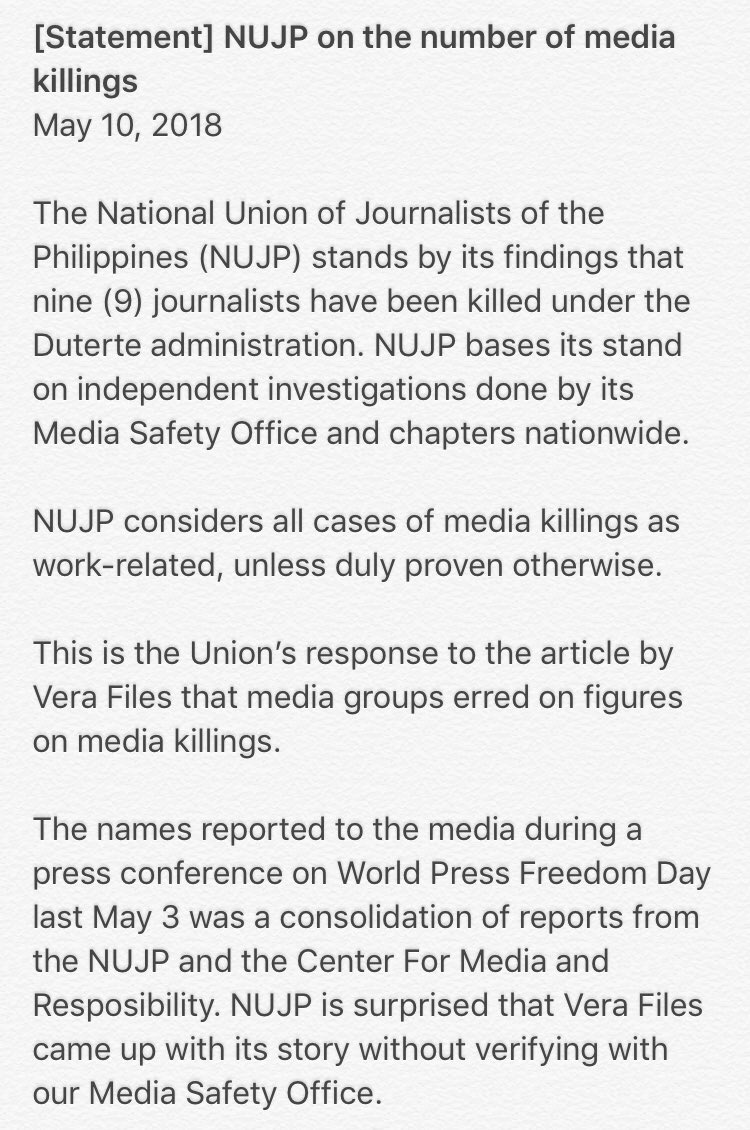
CMFR, in a statement posted
on its website May 11, said the fact check “failed to get the story right
on the level of both facts and context.” The center said that during the
preparation of the report, it had not yet included in its database all the
cases during the Duterte administration. It thus relied on NUJP’s figure
instead of relying on its own.
EDITOR’S NOTE: VERA Files had obtained the data from CMFR’s online database and additional details from its staff which it interviewed.
VERA Files depended primarily on CMFR’s online database because this enjoys a reputation of being highly reliable. The center is known for its longstanding practice of first carefully investigating the cases before concluding the motive. This is unlike NUJP’s practice of concluding all killings as work-related until proved otherwise.
Months after CMFR issued its statement, its online database continues to list only five work-related media killings in Duterte’s first 22 months. Rudy Alicaway, the journalist the May 11 statement says was killed because of work, continues to be on its list of nonwork-related killings. Two other journalists – Apolinario Suan and Marlon Muyco — still do not appear in CMFR’s database for both work- and nonwork-related killings.
Sources
Center for Media Freedom and Responsibility, Database on the Killings of Journalists in the Philippines since 1986
Center for Media Freedom and Responsibility, Cotabato radio blocktimer shot dead, February 24, 2017
Center for Media Freedom and Responsibility, Blocktimer survives ambush, July 20, 2016
Committee to Protect Journalists, Getting Away with Murder, Oct. 31, 2017
Reporters Without Borders, World Press Freedom Index 2018
Reporters Without Borders, RSF Index 2018: Hatred of journalism threatens democracies
(Guided by the code of principles of the International Fact-Checking Network at Poynter, VERA Files tracks the false claims, flip-flops, misleading statements of public officials and figures, and debunks them with factual evidence. Find out more about this initiative and our methodology.)
